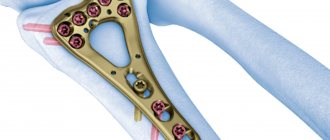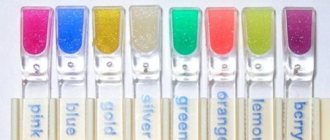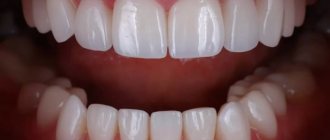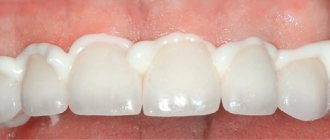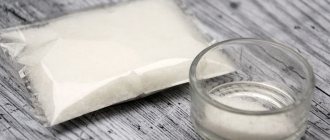2062
Gypsum is formed as a result of drying out water bodies by deposition of sediment from compounds saturated with sulfate salts, or by weathering of rocks.
This material, created by nature, is considered to be the most common auxiliary mass in dentistry, the demand for which has not decreased over the years due to its beneficial properties.
What is dental plaster
To understand the essence of what this dental material is, what stages of processing it goes through before starting to manufacture structures from it, it is worth finding out how it differs from natural gypsum and how it is obtained.
The territory of Russia is rich in minerals, including gypsum, the main deposits of which are concentrated in the Tula, Irkutsk regions, Perm and Krasnodar territories.
When mined, it appears as solid crystals of green, pink, yellow or brown. Pure gypsum is colorless, but due to the admixtures of quartz, pyrite, carbonates, and clay, this natural material acquires color. It is extremely rare without impurities.
Before plaster becomes suitable for use in dentistry, it undergoes special processing. It needs to be converted from its natural state - calcium sulfate dihydrate - to calcium sulfate hemihydrate. To do this, the material is crushed to a powder state. The crushing process in the mill is accompanied by simultaneous heating.
Main methods of obtaining:
- under conditions of high pressure - in an autoclave, for 6 hours at a temperature of 120-124 °C. After this, the material is dried, resulting in α-hemihydrate;
- under normal atmospheric pressure - for 12 hours at temperatures up to 165 °C. In this way the β-hemihydrate is obtained.
The resulting powder is carefully sifted and the following is added to its composition:
- catalysts and inhibitors - substances that affect strength characteristics and solidification rate;
- dyes that give a wide variety of colors;
- flavorings (for example, the taste of “mint” - to increase the patient’s comfort).
The essence of the process described above comes down to the fact that as a result the material acquires strength and the ability to set. The finer the powder is ground, the higher these characteristics are. Compliance with the temperature regime is of particular importance: insufficiently high temperatures leave excess water in the plaster, which prevents its hardening.
When the temperature is exceeded, all the water evaporates and anhydride forms, which sets too quickly. If absolutely all the water evaporates when heated, a material is formed that is incapable of setting. After obtaining hemihydrides, dental materials are prepared from them for various purposes.
Composition and technical characteristics
In terms of its composition, dental gypsum is calcium sulfate dihydrate (CaS04 - 2H20). This is a sedimentary rock with a layered crystal lattice, formed by precipitated sulfate salts.
Gypsum is traditionally mined in lakes and lagoons from aqueous solutions through drying. Also, deposits of natural gypsum are found in mountainous areas along with limestones, rock salt, and clays.
Temperature treatment (firing or calcination) transforms the substance into calcium sulfate hemihydrate (CaS04)2 - H20, further heating - into anhydrite.
In dental practice, a semi-aqueous modification of gypsum is used, which has a number of necessary characteristics, namely:
- dimensional stability and accuracy;
- excellent color contrast;
- environmental safety;
- lack of taste and smell;
- insolubility under the influence of saliva;
- low shrinkage rates;
- affordable price.
When choosing an auxiliary material, it is necessary to pay attention to strength indicators, the degree of water absorption, the absence of metal impurities, the proportion of hydration water and volumetric expansion values.
Manufacturers supply gypsum powder in bags made of paper or cellophane impregnated with a water-repellent substance and packaged in jars equipped with ground-in lids. The packaging must contain information about the trade name of the product, information about the manufacturer and supplier, gypsum class, scope of use, color characteristics, net indicators. Also on the packaging there are recommendations about the rules and shelf life, and the batch number.
How do you get the material?
The crystals are colorless and transparent. However, all kinds of impurities, such as clay, pyrite, quartz or carbonate, color them in various shades - from pink to black. To obtain dental gypsum, the material at the first stage is cleaned of impurities and crushed to a powder state.
Next, the natural material is heated to a temperature sufficient to remove some of the water. There are several manufacturing methods. As a result of their use, medical, model plaster and super plaster are obtained. The composition of medical gypsum of all varieties is identical - (CaS04)2 - H20.
The material differs in structure and particle shape:
- The hemihydrate obtained by firing is medical gypsum (β-hemihydrate). The process of its manufacture is heating in an open boiler until some of the moisture evaporates. The material turns out to be porous and loose. Before use in dental practice, the powder is mixed with water in a 2:1 ratio.
- Model plaster (a-hemihydrate) is produced by autoclaving. When mixing non-porous powder with water, the following proportions are used - 5 parts of gypsum particles to 1-1.5 parts of water.
- To obtain super dental gypsum, the boiling method with the addition of chloride (magnesium or calcium) is used. Chlorides act as deflocculants, preventing the formation of flocs and promoting particle separation. When adding water, the traditional ratio is 5:1.
This is interesting: Metal-ceramic crown, pros and cons of prosthetics, service life and care
Video from a specialist:
How does medical plaster work?
For dental purposes, gypsum dihydrate is heated under the required pressure, mixed with water, after which the entire mixture hardens. The degree of hardening of gypsum is influenced by the following conditions: temperature, dispersion, mixing technique, quality and presence of impurities.
For conservative and post-surgical treatment of fractures and soft tissue damage, immobilization with plaster casts is widely used, which is the best means for external fixation of extremity bone fractures.
It is believed that the method of preparing and applying GP was first described by the Dutch physician A. Mathisen (1852), and in 1854, during the Crimean War, it was described and widely used by M.I. Pirogov. He also paid great attention to caring for the condition of the casted limb.
Gypsum quality control
As mentioned earlier, the quality of gypsum is directly proportional to proper firing and other factors - humidity, amount of water for mixing, etc. In connection with these parameters, there is quality control of gypsum, which consists of testing:
- for strength - a ball is made with a diameter of 1.5-2.5 cm. Descends from a height of 1.5 m to the floor - normally remains intact;
- for flowability - gypsum powder is compressed in a fist - normally there should be no lumps left in the palm, plaster seeps between the fingers;
- for humidity - the plaster is heated on a metal plate with a mirror held over it. If the plaster is of high quality and not damp, then the mirror will not fog up;
- for hardening - a paste-like mass is made (2 parts water and 3 parts gypsum), which hardens within 10-12 minutes and does not crumble when broken;
- for viscosity - make a plaster splint (4-5 layers), apply it to the forearm, after hardening it should retain its given shape, not crumble or delaminate;
- odor - if the gypsum is unsuitable when mixed with water, the smell of hydrogen sulfide (rotten eggs) appears.
Description of material
In nature, the material is an aqueous potassium sulfate salt. In other words, it is a mineral whose crystal lattice is layered, distinguished by the regular arrangement of atoms.
The crystals are colorless and almost transparent, but due to the presence of various impurities (usually quartz, clay, carbonates, pyrite), they have a pink, yellow or black tint. The material is extremely rare in nature without impurities.
To obtain semi-aqueous gypsum, the natural composition is purified from all kinds of impurities. Then it is crushed in special crushers to a powdery state, loaded into boilers and fired for 10-12 hours at 150-190°C.
Based on how much and at what pressure and temperature the gypsum was fired, different grades of it are obtained, differing in strength and hardening period.
You can get plaster of two modifications:
- α-gypsum. The structure is durable, has a small specific surface area, low water requirement, high strength and a long setting period.
- β-gypsum. It is characterized by pronounced reactivity, a wide internal surface, low strength compared to α-gypsum, and requires a larger volume of water for dissolution.
As a dental material, plaster has the following characteristics:
- available;
- allows you to obtain accurate impressions;
- safe;
- tasteless and odorless;
- fragile;
- very low shrinkage rate;
- insoluble in saliva;
- does not swell when wetted with water;
- Easily removed from models using simple release agents (for example, soap solution).
Classification
According to the requirements of the international hardness standard, the following types are distinguished:
— soft gypsum, used for making impressions in orthopedic dentistry;
- ordinary (medical) plaster, used in general surgery and orthopedics;
— hard plaster, intended for making models of jaws in dentistry;
— especially strong plaster, used to create collapsible models of jaws;
- ultra-strong plaster, intended for models in dental orthopedics that require ultra-high strength, made with the addition of synthetic components.
When mixed with water, after 5-7 minutes the gypsum begins to harden, gaining strength. The material acquires its final characteristics and hardness after complete drying.
Types of gypsum in dentistry
There is a classification of dental plaster, according to which this material is divided according to hardness and purpose.
- Low hardness , intended for impressions. The softest and most pliable of all materials used in the dental industry. Characterized by low expansion and high hardening speed. It is used to create full or partial impressions, including when working with jaws that are completely devoid of teeth.
- Medical alabaster . It is an auxiliary material often used to recreate anatomical models used in various orthopedic structures. This class is not suitable for working models, as it has low strength characteristics, but is indispensable for technical work.
- High strength solid . Materials belonging to class 3 are used for prosthetics of partial and complete dentures. They are also suitable for making the base of collapsible permanent structures. It has decent strength indicators.
- Ultra-strong dental plaster of class 4 with reduced expansion. High strength and almost complete absence of expansion of the material when working with it makes this type of gypsum indispensable both for creating collapsible models and for carrying out combined dental work.
- Heavy-duty with adjustable expansion rate . A rare class of material with admixtures of various synthetic components. Articulating plaster is intended for working with high-precision models.
For complex structures, they work with several types of raw materials at once. For example, the base part is made from class 3 gypsum, and supergypsum is used to create the alveolar process and teeth. If the model must be resistant to high temperatures (up to +1000 degrees), quartz sand is added to the mixture. If it is necessary not to lose properties at +1500 degrees, special fire-resistant compounds should be used.
A little bit of history
People knew about its unique properties back in ancient times. Gypsum was originally used as a building material. Even before our era, it was used in Egypt for the construction of pyramids and other architectural structures.
Mass mining of the material began around the 12th–13th centuries. ad. Based on water, it began to be used throughout construction for plastering and finishing work. Various architectural elements were made from gypsum.
In the middle of the 19th century, or more precisely, at the height of the Crimean War, the Russian surgeon N. I. Pirogov was the first to use plaster mass during the treatment of bone fractures received from a gunshot wound.
To fix the bone fragments, he used bandages soaked in liquid plaster. A similar technique is actively used in surgery today.
In orthopedic dentistry, gypsum has a wide range of applications. For a long time it remained the only impression material.
In dental prosthetics, the material is necessary when plastering wax bases with artificial units in a cuvette and models in an occluder, and in the manufacture of metal dentures - to obtain a stamp sample. When making bridge systems, the technician uses plaster to temporarily hold teeth and crowns together .
The material can be used as a modeling material, when all elements are molded from it before casting a metal prosthesis. Extra finely ground gypsum powder is often used for polishing finished prosthetic structures.
How to apply dental plaster
The manufacture of a high-quality gypsum structure is impossible without properly organized preparatory and working stages. For example, improper storage of consumables, failure to maintain the proportions of powder and water when mixing, dooms even the most advanced technique to failure. What do you need to know about using dental plaster?
Preparation for use
Before directly mixing the material used, you should make sure that it has been stored correctly and also follow some operating rules.
The basic principles of its storage and use are simple:
- Store packages with material in a dry place and avoid contact with moisture.
- It is necessary to monitor the condition of containers and tools used in work: they must be dry and clean.
- Do not mix a large amount of plaster: there should be no more than enough for two or three impressions.
- Strictly observe the proportions of mixed powder and water.
- The temperature of working plaster and water should be 20±1 °C.
- After you have poured the consumable into the water, let it submerge in it, and only then start kneading. The optimal time for manual kneading is about one minute, for machine kneading - no more than 30 seconds.
- Once the dental plaster mixing process is complete, it is important to immediately pour it into the mold to set.
- The finished model is separated from the mold immediately after cooling.
This is interesting: Pros and cons of dental prosthetics without grinding
After you have made sure that the storage conditions are met and you have gypsum of the required quality, proceed to mixing.
Water used for mixing
To prepare the gypsum composition, settled tap water is used; the temperature should not exceed 19-210.
When using hard water, the hardening period of the mass is reduced. In this case, it makes sense to use demineralized water.
Powder addition
The powder is poured into the water evenly, but quickly enough (approximate time - 10 seconds). Then you need to wait 20 seconds until the plaster has completely settled.
Only after this can you start kneading with a spatula. The manual mixing time depends on the class of powder.
For low-strength material, the duration of this stage is 30 seconds. All other types of material are mixed for one minute.
Unboxing
According to the canons, exactly 30 minutes should pass from the moment the gypsum mass is poured to the removal of the frozen sample. To use other impression materials, unpacking is carried out after an hour.
Extension
Each class of material expands slightly as it hardens. This indicator is influenced by:
- compound;
- air humidity;
- ambient temperature.
To compare the degree of expansion of different classes, they must be placed in equal conditions.
The permissible expansion values for each class of a given material are given in accordance with ISO 6373 or EN 26873.
Following the standards, the expansion of the product should be indicated in % and after 2 hours, and the strength of the applied impact - after 1 hour (in N/mm2).
If the sample is kept at room temperature and insufficient humidity longer, its expansion decreases by approximately 30%. But in practice it is known that gypsum even needs a slight expansion - it covers the shrinkage of other materials .
How to mix dental plaster
A container and a spatula are enough for mixing. Gypsum is added to water at 20±1 °C at the rate of 100 g of powder per 22-24 ml of water. After it is completely immersed in water, we begin the kneading process. Remember: the more energetic the movements, the faster the material is mixed, and vice versa.
It can be mixed either manually or mechanically using vacuum mixers: such a gypsum solution is obtained faster and more homogeneously.
The average setting time is approximately 10 minutes. After obtaining a solution of a creamy consistency, you can pour gypsum into the mold.
Filling and modeling
Before filling the mold with the resulting solution, an impression of the jaw is first taken, which will be filled with the material. This impression is made from plaster or alginate mass. After receiving the impression, all its parts, including the smallest ones, are placed in an impression tray and secured with wax.
If the material for making the impression is very plastic, it is introduced into the patient’s oral cavity along with a spoon. Next, disconnect the spoon and remove the resulting cast. It is washed with soapy water to fill the cavities: this will make it easier to separate the cast plaster model from the cast. The impression is also treated with a disinfectant and special liquids to remove surface tension.
Pour the prepared plaster mixture into the resulting impression, while tapping and shaking it. This is necessary so that it is distributed and hardens evenly, so that hollow areas do not form during hardening.
In dental production, special equipment is currently used for these purposes - vibrating tables. As soon as the plaster in the mold loses its shine, you can begin modeling.
The following solidification phases are distinguished:
- within 30-50 seconds after adding water and kneading, the material has a creamy consistency;
- within 2-5 minutes it loses its shine, becomes thicker and more flexible, and begins to expand: this is the right time to start modeling;
- after this, within 1-3 minutes it loses its plasticity, begins to crumble, but is not yet hard and durable enough;
- in the next 5-8 minutes the material begins to generate heat and hardens: this means that it is time to separate the resulting model from the print.
How long does it take for dental plaster to harden? Complete crystallization requires 30 to 60 minutes. The higher the class of the material, the longer it takes to set. After filling the model, its base is made - a stand up to 2-2.5 cm wide. To do this, a “hill” of plaster is placed on a smooth, flat surface with a spatula, and the print is tipped onto it.
It is especially important that the bottom of the impression tray is strictly parallel to the surface being tilted, and, accordingly, the edges of the resulting base are perpendicular. Excess hardened material is removed with a spatula and a plaster knife or using trimmers.
After completing the modeling process, the finished model is carefully removed from the mold. First, the small parts are separated, then the large ones. This work requires special care, since it is very easy to damage the model during removal.
This is interesting: Aligners for straightening teeth are the best alternative to braces for correcting a bite
Hand kneading technology
You can get a high-quality plaster cast only if you follow the mixing sequence:
- Distilled water is poured into a special bowl, the amount of which is determined by the class of the powder.
- Gypsum powder is slowly poured into the liquid. According to standards, about 10 seconds should pass from the start of contact of the first particles with water to the end of falling asleep.
- After this, you should wait until the particles are completely immersed in water and only then start mixing with a metal or plastic spatula.
- Movements should be as energetic as possible. The consistency of the complete mixture is creamy and homogeneous.
If too much water is added, the plaster will only absorb the amount it needs. The remaining water will quickly make the structure of the material loose and reduce the accuracy of the impression. Not the best solution would be to add less liquid than required by the technology for producing the mixture. Thick plaster does not make it possible to obtain an accurate imprint due to the formation of air bubbles that simply do not have time to reach the surface due to too rapid hardening.
Taking an impression of the upper jaw on video:
Shelf life
Gypsum should always be packaged in a moisture-proof container that does not alter its physical and chemical properties. The container must be clearly marked.
It must indicate:
- trade (factory) name of the product;
- the name of the manufacturer and supplier, as well as their address;
- gypsum class;
- the intended scope of its application;
- color (if it is not white);
- smell;
- net indicator;
- indication of the expiration date of the period of application;
- basic storage rules with the obligatory indication that gypsum is susceptible to deterioration at atmospheric pressure and high humidity;
- Issued batch number.
Transportation and subsequent storage is possible only in the original packaging. The shelf life during which the manufacturer guarantees the quality of the released material and the preservation of characteristics subject to storage rules is 1 year.
The video provides additional information on the topic of the article.
Application of inhibitors and catalysts
The strength characteristics of prints and models are affected by the rate of hardening. However, dental technicians prefer not to use special accelerators and retarders of the process. Additives can degrade the quality of products.
The optimal solution is to select high-quality raw materials and adhere to production technology (choice of temperature conditions, powder dispersion, intensity of mixing components).
But in rare cases, it is also permissible to use hardening optimizers, which are:
- table salt solution, potassium nitrate (catalysts);
- ethyl alcohol (5%), sugar solution (5-6%), borax solution (2-3%), wood glue (inhibitors).
Accelerators (catalysts) reduce the strength and hardness of future casts. Inhibitors, on the contrary, increase these characteristics. Additives cannot be used when creating jaw models, as the likelihood of errors and inaccuracies increases. Inhibitors and catalysts are added both to water and directly to gypsum powder.
Diverse orthopedic material is widely used in dentistry due to its ease of use, affordable price, and excellent aesthetic and functional characteristics. By following the technique of making impressions and models, it is possible to create high-quality impressions that facilitate diagnostics and measures for dental prosthetics.
Reviews
Plaster is a versatile dental material. The stability of its characteristics and quality, as well as its correct use, facilitate the work of specialists and increase the aesthetic and functional characteristics of prosthetic structures.
At the same time, the material improves the outcome of human treatment, and therefore affects the quality of his life.
You can share your opinion about the advisability of using gypsum in dentistry and its role in dental prosthetics by leaving it in the comments to this article.
If you find an error, please select a piece of text and press Ctrl+Enter.
Tags: gypsum in dentistry, dentures
Did you like the article? stay tuned
Previous article
The procedure for polishing a prosthesis to improve strength and aesthetic qualities
Next article
What is a direct abutment and for what purpose is it used?
How to avoid defects in model making
From the description of the technology for making models from dental plaster, it is clear that there are subtleties that must be observed to avoid defects. Let's list the main ones.
First of all, the condition of the jaw impression being filled with wax: it must be free of saliva. Another important aspect is that the structure of the material used is porous. The use of vibrating tables minimizes the risk of cavities.
If there is no such equipment, watch your own manipulations. Be careful when separating the model from the print; if necessary, tap it with a special hammer. Use isolating solutions before pouring the dental plaster to make it easier to separate the model from the impression.
During work, always pay due attention to maintaining the required temperatures of water and material, their proportions, and consistency. Be aware of proper storage conditions, containers and tools. To achieve the highest quality and fastest results, combine, if possible, manual and machine processing.
Wetting the model
Sudden temperature changes can increase the fragility of the plaster model, which can cause it to wear out quickly.
Therefore, if steam or other heat treatment is necessary, it is recommended to moisten the sample.
Also, short wetting helps prevent the structure from breaking during sawing or preparation.
From the video you will learn how to create a plaster model.
Model defects
To avoid spreading of the sample and other unpleasant surprises, the cavity between the gypsum composition and the alginate mass should be treated.
For this, a neutralizing solution, water or dry gypsum powder can be used . Instructions for using polyester impression material are indicated in the instructions.
Terms of use
It is important for all specialists working with gypsum mass to adhere to the following rules:
- The material should be kept in a dry place.
- Before filling the storage container with a new portion, it must be thoroughly cleaned.
- All accessories and equipment used to work with plaster must be cleaned after each use.
- A single portion of material should not exceed the volume required to fill 2-3 prints.
- To speed up the hardening of the product, it is not recommended to add hardening accelerators to it. If necessary, it is better to take a quick-hardening brand of gypsum. By increasing the time for mixing the material by a couple of seconds, you can speed up its subsequent hardening.
- To prevent the expansion of the mass from exceeding the required parameters, when mixing, the proportions of water and added powder should be observed.
- The temperature of water and gypsum powder should be 19-20°C. A deviation of this indicator by 1°C upward or downward is allowed.
- The powder must be poured into the water slowly, while giving it time to completely immerse in it. Then within 1 min. Gently mix the mixture with a spatula. Following manual mixing, machine mixing should last no more than 30 seconds.
- The composition is poured into the mold immediately upon completion of mixing. It is unacceptable to increase the pouring time of the mixture or add water to it.
- The impression can be removed only after the temperature in the model has decreased.
Compliance with the listed rules will allow specialists to work with plaster comfortably, economically and quickly.
Where can I buy
Medical gypsum is produced by companies that produce products for construction and finishing works. Its main difference from gypsum for construction purposes is the degree of grinding, and as a result, faster hardening times. You can purchase plaster for medical practice directly from the manufacturer. One of the leading companies is Volma.
